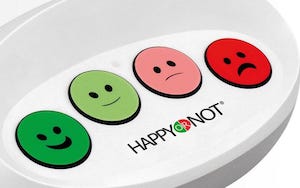Think for a second of how you open your email for the first time of the day. If you’re like me, you will scan the inbox and start by looking for the meaningful senders and messages, with a sneak peak on the subject. But before delectating the good emails, I delete the bad and the ugly.

On any morning I am lucky if I have 3 truly interesting messages that I am keen to open up. My first action, though, is to go down and select all the spammy messages to rid myself of the undesirables, including unsolicited requests and innumerable newsletters from which I really ought to unsubscribe. A classic case in point is “Adore Me” that insists on telling me things like: You’re a Winner! You’re so special! Found your new BRA! Sunday Freebies!

“Adore Me” knows absolutely NOTHING about me and they treat me as an irrelevant number. I’ve kept a record that they have sent me about 3 mails a week ever since I signed up two years ago. Non-stop spam. [And if you’re wondering why I have kept subscribed, I’ve many subscriptions like this to keep a finger on the pulse.] The Adore Me CRM team is clearly devoid of any notion of customer centricity.
Need to become more customer-centric?
Companies are seemingly falling over themselves to become the next most customer-centric organization (behind All Hail: Amazon, whose mission is to be the Earth’s most customer centric company). Yet, we continue to see companies like Adore Me endlessly trying to inhale email addresses as they pump out boring, cheesy or clickbaity emails to pollute our inboxes. How can this still be true in 2019? I was told by Ashley Galina Dudarenok, a premier China marketing expert, that such behavior in China is not only passé, it’s quasi illegal, in that you will immediately be called out for your unwanted spam. In China, where everything happens in the social networks (i.e. not on email), you can’t hide. Your official identity is tied to your telephone number which is also tied to your payment methods… which are all bundled into your Chinese social media accounts. In the West, meanwhile, the eco-system and cultural context is different. Here, we have a tendency to be extremely nervy about invasions of privacy, while also complaining about the non-personalised and irrelevant messages we keep receiving from companies (largely because we don’t want to hand over all our data). It’s a veritable catch-22 in the eyes of marketing executives who are blindly clinging to the old-school mentality. If marketers were to get with the new program, they would realize that they need to provide supremely valuable and outstanding content that honors the recipient’s time and attention. That would be customer centricity. But how to get to that point?
“Marketers need to provide supremely valuable and outstanding content that honors the recipient’s time and attention.”
To become truly customer centric
For marketers to start shifting to real customer centricity, I posit that they will need three key ingredients:
- empathy
- being present (i.e. during the time of writing an email, talking to a customer)
- metrics that focus on the value received (i.e. perceived)
1/ Developing empathy

I believe that empathy is a superpower. In business, I focus on cognitive empathy, which is about understanding the emotions and context of the recipient. How does one go about developing more empathy, especially for the customer? This requires removing yourself, your challenges and preconceptions from your filter in order to get truly into the customers’ shoes. For starters, you can go out and experience the customer journey for yourself; but be sure to make sure you are characterized as a customer and not as some executive or employee of the company! Or you can go listen to and watch them. Keep a beady eye out for their emotional responses (that’s where the gold is). As I describe in my book, Heartificial Empathy, there are plenty of ways to develop your empathy. I underscore that it’s important that the culture of empathy be spread throughout the organisation, not just in the marketing department. And, I’d add, that it had best start at the top.
2/ The present of being present

The second key ingredient is to be more in the present moment at the time of engaging with the customer. Whether it’s when writing an email or social media post, or interacting with her on the phone or in the store, being present means learning to block out the busy-ness that invades our mind. It also means eliminating past preconceptions and worries, not jumping to conclusions or fretting about the consequences for tomorrow. What are the ways to become more present? For starters, I suggest meditation every morning. Secondly, practice being present whenever you are interacting with someone… because the act of being present is like flexing a muscle. It takes discipline and work to quell the busy-ness. Another major benefit of promoting being present (N.B. not “presenteeism”) is that it can help combat mental health issues and burnout.
3/ New metrics

It’s remarkable how frequently opportunities for feedback are missed. I’ve often wondered how many of those ‘recorded’ calls we make to customer service are actually listened to again? There is no better option than to have customers provide live feedback; but it’s often not practical or realistic. If you have a sweet and simple smiley button response at the exit (e.g. HappyorNot), it’s not going to be effective unless you are able to correlate the ups and downs with data about the customers’ experience. Whatever methods you employ, you ought to be looking for ways to measure how much you delight your core customers. Complaints are a gift, but do you have appropriate channels for the feedback and do you track them? Finally, where most CRM teams are measuring the open and click-through rates, they systematically ignore the dissatisfaction of the 98% who didn’t open the message. In that 98% there are not only core and potential customers, but there is a volume of golden feedback that typically festers as you continue to spam them. How can you create metrics that assess the bona fide value you’re providing your customers? And, I might add, you should also be watching out for how rate on the irritation index!
Your thoughts?











